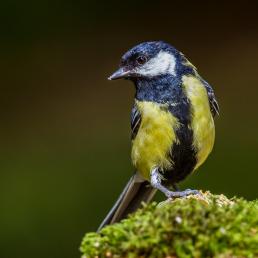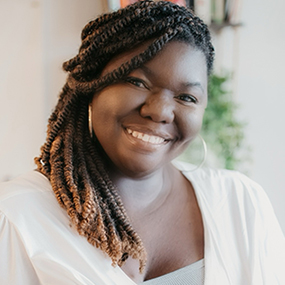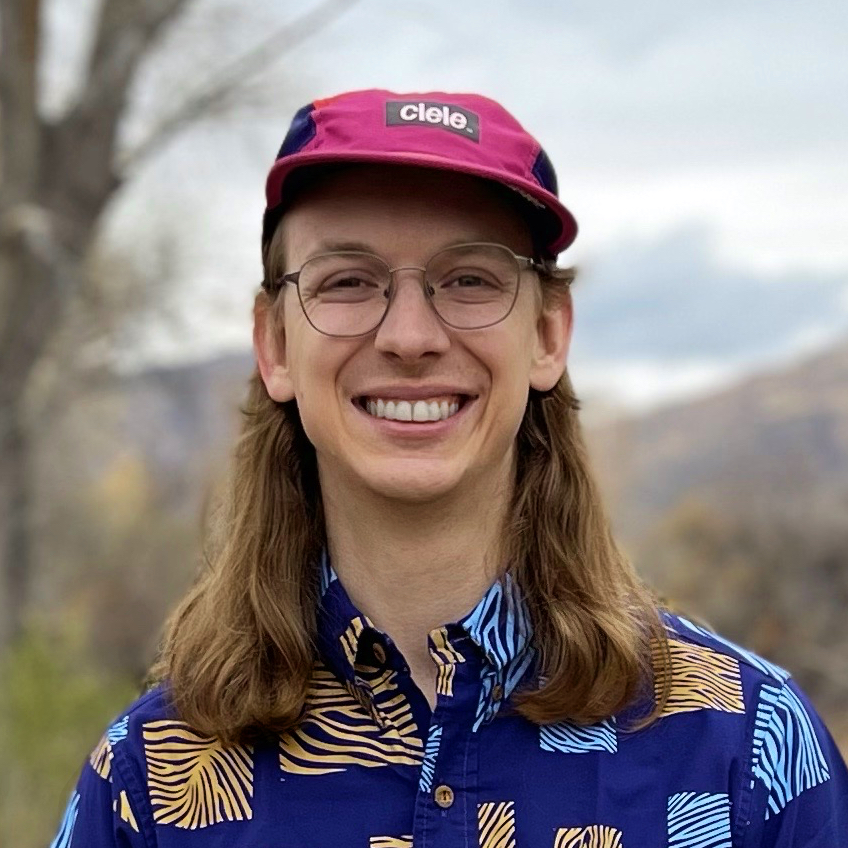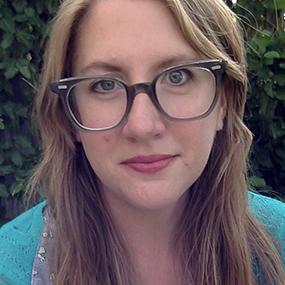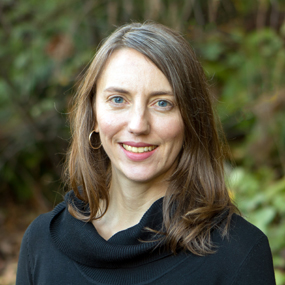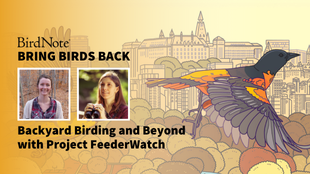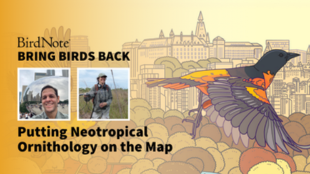

Join BirdNote tomorrow, November 30th!
Illustrator David Sibley and actor H. Jon Benjamin will face off in the bird illustration battle of the century during BirdNote's Year-end Celebration and Auction!
In this installment, host Tenijah Hamilton joins volunteers planting wildflowers and grasses along Atlanta’s BeltLine, an urban rail trail, where she learns how native plants can provide food and shelter for birds within cities. She talks to ecologist Desiree Narango about why birds depend on plants, and how we can transform our backyards and shared green spaces to serve the needs of both people and birds.
Tenijah Hamilton: BirdNote presents.
Tenijah Hamilton: It is a bright and sunny morning in Atlanta. We are on the Atlanta BeltLine, which is right in the city in this really beautiful area. It's kind of like a juxtaposition of the city and a lot of green spaces. And that was obviously very intentional. So we are here. It is around 9:00 AM ish, and we are at a project on the BeltLine being hosted by Georgia Audubon as well as Trees Atlanta. They are planting native plants, which will help all the birds because of a lot of reasons. So we're going to talk to some folks today. We’re going to learn more about it. It’s going to be a really good time.
Can I shovel something too?
Brian Williams: Sure. You can, you can have this whole box. This one can be yours.
Tenijah Hamilton: This is Brian Williams from Trees Atlanta. Now, I do not have a lot of experience with gardening, so he's going to teach me how to help these plants rather than kill them. Like … what’s the opposite of a green thumb? Whatever that is, that is what I have. Thumb war queen? You got it. Green thumb, absolutely not.
Brian Williams: Try the dirt. You're going to see it's softer than it looks.
Tenijah Hamilton: Okay. This is me trying the dirt.
Tenijah Hamilton: He gives me a flower to plant. And it’s called bee balm.
Brian Williams: That is a bee balm. It has got a pink flower on it. And as its name suggests, very attractive to bees. And the one really cool thing about that plant, take one of the little leaves, not one of the ones that it needs, and kind of bruise it and smell it.
Tenijah Hamilton: Hm.
Brian Williams: What does that remind you of?
Tenijah Hamilton: Oh, no, I'm afraid to get the answer wrong. I'm not—
Brian Williams: Something you probably use in your kitchen.
Tenijah Hamilton: Is it basil-y?
Brian Williams: Smells like oregano to me. Yeah. Basil. So this is in the mint family. Just like those, those kitchen herbs that you use.
Tenijah Hamilton: And then, the moment of truth: putting this plant in its new home.
Brian Williams: you're just going around all the sides here. And then the last thing I do, I take my hands and I kinda, I do put a little bit of body weight on it at that point, just to firm up the soil.
Tenijah Hamilton: Awesome.
Brian Williams: There you go.
Tenijah Hamilton: Thank you.
Brian Williams: You planted that one!
Tenijah Hamilton: Well for me, that was a momentous occasion!
[theme music]
Tenijah Hamilton: One reason we've lost so many birds in North America is that they've lost their habitats, or those habitats have changed so much, they can't live there anymore. And you can't talk about habitat without talking about plants: the trees, shrubs, grasses and wildflowers where birds find food and shelter. In the U.S., we’ve transformed native ecosystems with non-native species for agriculture and for our lawns and gardens. Over 900 of our plants are listed as endangered or threatened. Globally, two out of every five plant species are at risk of extinction. That’s making it harder and harder for birds to find what they need in the landscape — the plant species they've evolved alongside for millions of years.
But that also means every native plant you put in the ground is one step closer to making our communities friendlier for birds, giving them places to live around us.
Today on Bring Birds Back, we're talking about — and actually planting — native plants. Later I’ll meet up with conservationist and researcher Desiree Narango to talk about why native plants are so important to birds. And I’ll find out what you and I can do to support our populations of native plants that give our birds a place to live.
[music fades]
At the BeltLine, I met up with Greg Levine, the co-executive director of Trees Atlanta.
Tenijah Hamilton: What is it like for you to come out here and see all these people who are volunteering their time to do this work?
Greg Levine: I started off doing projects every Saturday. And that's why I love one of the many reasons why I love working for Trees Atlanta, the volunteer component. I mean, the best people in the world go out and volunteer, I think. So today we have about 20 volunteers, all different ages and backgrounds.
Tenijah Hamilton: So I stand up for a minute to stretch and meet some of my fellow volunteers. And I meet someone who brings a fresh perspective to the value of Georgia's plants.
Tenijah Hamilton: Hi, what's your name?
Luis: Luis.
Tenijah Hamilton: Luis — I’m Tenijah.
Luis: Yeah, I'm a member of the Audubon society, or Georgia Audubon I should say, and also the native plant society. Yeah, I love birds. That's what started me doing these kinds of things. I'm actually a native of Peru, an area that is kind of desertic. And so when I moved here, I came to appreciate this forest and the green spaces and all the wildlife that lives here. So it's absolutely amazing.
So what we're trying to do here is decorate the BeltLine with beautiful plants that are native to this area that help all wildlife. So, you know, as humans enjoy, as we walk or cycle by here, birds and all the animals can also benefit from it. So it's a win-win.
Tenijah Hamilton: Hearing Luis speak passionately about the BeltLine reminds me of some of the things I love about this place. The BeltLine and urban green spaces like it help combat the unequal access to nature for Black folks, Indigenous people, and people of color. And it’s not just about connecting with wildlife. Urban parks actually help cool down neighborhoods in the summer by providing shade and releasing moisture into the air through plant leaves. So nurturing these green spaces can really benefit communities of color in a tangible way.
Brian Williams — the one who helped me with that bee balm — is the Director of Urban Forestry for Trees Atlanta. He's leading the group as we add some native plants around a Chimney Swift tower. It's a wooden structure shaped like a chimney where birds called swifts can live. Chimney Swifts eat flying insects, and flying insects love native wildflowers.
Brian Williams: So the dynamic here is we're creating a buffet.
Tenijah Hamilton: Brian’s demonstrating the best planting technique for us.
Brian Williams: So I'm just giving it enough looseness to where these outside roots will start to grow out, putting it in the ground at grade, and then I'm just back-filling around it.
Tenijah Hamilton: So, Brian is busting some planting myths here. You don’t want a mound of dirt over the roots, just level with the surrounding soil. And you don’t want to spread out the roots to give them breathing room.
Brian Williams: Air pockets dry out the roots.
Tenijah Hamilton: That is not what these flowers want.
Brian Williams: So you really want to make sure it's packed in there tight. And that is it. You know, for your vegetable garden, you want fertility, you add a lot of fertilizer or compost, or what have you. For the native plants, they don't need a lot of nutrients. They're used to growing in depleted soils. What they need is what they call tilth, which means water can percolate into the soil.
Tenijah Hamilton: I'm loving this Wildflower Gardening 101. Things are clicking for me. I’m learning that native plants don’t need a lot of extra added stuff to the soil to grow. Standing water on the ground? Not a great place to plant, because the soil needs to drain, letting water pass through.
Brian introduces us to who we're planting today.
Brian Williams: Purple coneflower, it's right here. Everybody's got a few of these. This is kind of a generalist plant. This is Liatris. This makes a purple kind of spike. And this is a threadleaf milkweed, which if y'all know about monarchs and milkweed, this isn't, I think, necessarily their favorite plant. But this is a different type of milkweed that's native to this area that we don't plant enough of, that does serve a lot of butterflies.
Lastly, your grasses, and these are the least showy. And I feel like people are the least into these, but these are important. These are like the backbone of the planting.
Tenijah Hamilton: Cindy’s one of the volunteers working next to me. She fills me in on how the grasses help support everything growing around them.
Cindy: And so you kind of want to intersperse these grasses in with your flowers. Otherwise, what happens is you have wonderful grasses and then you have your flowers just laying on the ground.
Tenijah Hamilton: I see what she means. We’re planting a grass called little bluestem, and it could not be more different than the typical grass in your lawn. It has thick leaves growing in dense bunches that hold onto the soil and support plants growing nearby. But Cindy says looking good is important, too.
Cindy: We always go for aesthetics, okay. You always want it to look good because when it looks good, people don't mess with it. They come and they say, oh, isn't that pretty? I, gee, I could do that at my house!
Tenijah Hamilton: Cindy knows all about that. Her front yard is like a showroom for native gardening.
Cindy: Every blade of grass has been taken out and it's completely covered in native grasses and wildflowers.That's all it is. My dogs run through it. You know, we have a great time with it. The plants are beautiful. They bloom all year long. I have a succession of bloomers, some are springtime bloomers. Some are summer bloomers, some are fall bloomers. You know, the birds love it. I have lots of them that come through it.
Tenijah Hamilton: And what’s really cool is Cindy sees the connection between plants and birds right around her home.
Cindy: Native birds are in decline. Migratory birds are in decline. And part of the reason they're in decline is because we've taken out their food sources. Yes, it would be like putting you down in a whole new environment and you have no clue about the food sources there. You don't know what to eat, but they eat insects. You bring insects in and the birds will come in. That helps everybody. It looks good. The birds get to eat it. It's a great buffet.
Tenijah Hamilton: Also here is Gavin Allvine. He’s currently the youngest person to have completed Georgia Audubon’s Master Birder certification program. He’s going to introduce us to the Chimney Swifts.
Gavin Allvine: I've seen a bunch fly over lately. The best description, and this is clearly not mine, is a flying cigar with like — they're very short and stubby, with exaggerated long wings. But unlike a swallow, Chimney Swifts have longer wings and are more closer to the hummingbirds.
A cool thing about Chimney Swifts is that they don't like to land, they can't even walk. So if they land on the ground, it's over, they can't take off. Chimney Swifts really do like literally everything in the sky: drinking, feeding. However, they do have really strong claws so they can hang on vertically to surfaces.
Tenijah Hamilton: And so is that the importance of these towers here, the Chimney Swift towers? So, because they don't touch the ground, they need to have these places to land, build their nests and things like that?
Gavin Allvine: Exactly.
Tenijah Hamilton: Zaria Dyer, a Conservation Program Associate with Georgia Audubon, says that one reason it's important to plant native is because of the way plants and insects have evolved together.
Zaria Dyer: So, one thing is that a lot of people don't realize that insects are specialists. So that means that they co-evolved with certain plants to be able to eat them.
Tenijah Hamilton: She says plants defend themselves from critters that want to eat them by making special chemicals...
Zaria Dyer: Such as plant volatiles, things like that, which make them inedible to certain insects. Like for instance, have you ever had pineapple and it burns your tongue? So that's its plant volatiles. That's the compounds that it makes to protect itself.
Tenijah Hamilton: Zaria explains that insects have evolved ways around plant defenses. They’ve adapted to tolerate some of these plant chemicals. That's why bugs can eat some of these plants that are toxic or bitter to you and me. But there are limits. Many insects can only survive on the plants that their ancestors have been eating for millions of years.
Zaria Dyer: So milkweed would be a great example of talking about, like, a host plant and why they're important, because only certain butterflies are able to use milkweed as a host plant.
So the thing is when we brought in a lot of these non-native, invasive plants, the insects that were here, they were not able to eat them, because again, they're not used to them. They didn't co-evolve with them. So when we restore areas and we bring native plants back, those plants are able to host those insects, give those insects something to eat, something to lay their eggs on, things of that nature. That in turn brings back the birds and other animals.
Tenijah Hamilton: This idea that Zaria’s talking about here — the connection between plants, the insects they host, and the birds they attract — is so important.
[music rises]
Tenijah Hamilton: Planting and talking to people on the BeltLine was so much fun. These folks know their plants. There were so many knowledgeable and passionate people there doing what they could to help solve a huge problem. But it made me think: this is just one place in Atlanta. And there are probably hundreds of local initiatives like this elsewhere. But how do we tie it all together nationwide? What are we going to do about all the native plants we've lost across the U.S.? When we come back, we’re going to talk about what everyday folks can do to bring back birds by bringing back native plants. We’ll dig into that more soon. Pun intended.
[MIDROLL]
Welcome back. I'm talking to the perfect person to ask about birds, bees and plants. Meet Desiree Narango. She's a postdoctoral fellow at the University of Massachusetts Amherst and the U.S. Forest Service. She's also a David H. Smith Conservation Research Fellow. For her PhD at the University of Delaware, she studied how nonnative plants affect food webs in residential areas. Her goal is to figure out how we can meet the needs of both people and wildlife in our communities.
Desiree, it is so nice to have you on the show!
Desiree Narango: Hi, Tenijah, it's great to meet you and to be on the show too.
Tenijah Hamilton: So I'm thinking again about my time on the Atlanta BeltLine. And our mission was to, you know, really help the Chimney Swifts in that particular project. Something cool that I learned about Chimney Swifts, they kind of eat while flying, right? How has the decline in insects really affected birds like them?
Desiree Narango: Declines in what we call aerial insectivores, so, insect eaters on the wing. That's my fancy word for that. We see declines in that group of birds across the board. They're not doing well. And these are species that rely solely on insects, so they don't eat anything else. They can't eat fruit, they can't eat your bird seed.
So here's an example. When we change a plant community, we might be thinking about on the ground, in the forest. But those plants are producing flying insects that go into the air. And so the way that we treat the habitat around us is going to affect the biomass of insects that are available for these birds that are almost exclusively — well for Chimney Swifts, exclusively feeding on the wing. So we need to make sure that we are restoring and protecting habitat that can then funnel all of that delicious food up into the air for them.
Tenijah Hamilton: So I know that many insects coevolved really closely with the plants that they eat and live on. But just how tight is that relationship?
Desiree Narango: Sure, so, some of the most apparent and dramatic specializations that we see are in insects and especially in plant-eating insects. And the reason for that is because these insects, like caterpillars, but also some beetles and aphids, are directly tied to their food resource. And for many of them, that's where they spend the majority of their life, is right on their plant, eating it. That's all they're doing.
So, I started as an ornithologist, someone who studies birds and I knew birds really well. And then I started on a research project that also studied what birds eat, which is insects. And then when I learned about, like, all of these specializations that were occurring and then, and then finding out that more than 90% of our plant-eating insects are specialized to just a few plants. I was like, mind blown. And I already had a degree, you know?
Tenijah Hamilton: That is wild. Okay, so put it all together for me. Can you talk about how the plants affect the insects, and then how those insects affect the birds?
Desiree Narango: It's definitely all interconnected. Insects and plant-eating insects in particular, like caterpillars, are really wonderful sources of protein, which is great for building bones and growing feathers. And so these plants that support a lot of the different species of insects are also supporting a lot of different species of birds, too.
[music]
Desiree Narango: When we think about conserving species, we also need to think about conserving species interactions, because it's not enough to just think about one species and maybe one habitat that they need, but think about all of those connections that lead to that songbird being able to produce young or that bumblebee being able to survive the winter.
[music fades]
Tenijah Hamilton: Every region has its own set of native plants, right? And new species. If I'm like, okay, I want to make a change, I'm influenced — you've done it, Desiree, you have changed me for the better — how do you even know what plants you should be getting? Who do you ask?
Desiree Narango: Sure. So one of the first places that you can start to get really wonderful information is your local extension center at a university that will give you information on what plants are native, which ones are invasive, what’s really local to the ecosystems that are around you.
And then there's also some resources online. So the National Wildlife Federation and the National Audubon Society both have websites that you can visit where you can plug in your zip code and it can give you some lists of things that are native to your area, and also some recommendations for plants that might be great for birds or great for insects.
Tenijah Hamilton: Alright, so there's what I can choose to do as an individual, but I'm also really interested in how this issue intersects with policy. What can be done on a governmental level to bring back and boost the populations of native plants?
Desiree Narango: What we need is better incentives and initiatives. And you know, especially for restoration and management of urban and suburban areas. Policy happens at all kinds of levels — so at the state, at the town level. And so towns can make huge differences. I think actually Somerville, Massachusetts, was the first town in the United States to require that 80% of their trees are native in the street tree canopy, which is a huge thing.
[music]
Tenijah Hamilton: So Doug Tallamy, who was one of your advisors for your PhD research, he's an ecologist who has helped create this initiative called the Homegrown National Park. Can you tell me a little more about what that is?
Desiree Narango: Sure. So kind of the idea of the Homegrown National Park is that we should be thinking about all of our properties as kind of an interconnected system, and the most easy to access national park that there is. Because if we think about all of the land area that's locked up in our residential properties, I believe it's more than the amount of land that's protected as national parks.
And so if we think about how much biodiversity that these properties in aggregate could support, if we treated them with the same respect and tried to restore the ecological function, then we will have a national park that is easy to access.
[music fades]
Tenijah Hamilton: Yeah. I mean, I would like a homegrown national park, but I'm a renter and a lot of folks are renters. So what do you kind of recommend for folks in that situation to do where they might not have access to a lot of space or they might not even have their own lawns, but maybe you have like a little space if you are in a townhome or, you know, a community garden, are there things you recommend?
Desiree Narango: Yeah, so, even in the smallest spaces, you can make a difference. And so even something as simple as — I've seen people put little potted plants on their porch. If it's supporting pollinators or maybe attracting hummingbirds, that's a contribution, even in that tiny little space. But you know, some of the other ways that you can contribute is to share the knowledge.
You know, I talked to my landlord, I said, why don't you keep this area and don't mow it? And it didn't take much convincing. So maybe starting that conversation with the person that does manage that property can maybe help open their eyes a little bit too, about how they might rethink about the next tree that they plant or the next garden that they put in.
You mentioned community gardens. There are wonderful green spaces like that in urban and suburban areas that you can get involved with and help with, with landscaping or help with the restoration of those properties.
Tenijah Hamilton: Coming from a place of optimism about our future and what the ecosystem and the environment looks like, what is your dream for urban-suburban restoration? And what does that look like over time?
Desiree Narango: I also come from a place of optimism.
Desiree Narango: I am, I am optimistic. You know, I guess my dream for the future is really that I envision urban and suburban ecosystems that are intimately entwined with ecological health. And so we're having properties that are supporting wildlife, but are also supporting us in the services that we need.
And so we start to think about those plants and animals more as our neighbors that we are taking care of and less of a property that needs to be managed.
[music]
So, you know, if you think about it, the way that lawns are currently managed can homogenize areas. So instead of having diverse habitat, you just have one or a few species of grass that make up an area, turf grass.
So I have a preschooler. He likes to play outside. Right? So I will probably never get rid of all of my lawn so that he has a place to play soccer. But I think the next step is really, you know, where we need to think about lawns going forward is: how can we rethink what the lawn is? We don't want turf grass. We want to have a beautiful lawn that has native wildflowers like bluets and violets that come up and support our pollinators, but also provides a place that we can use.
I guess what I see for the future is a world where we can share our spaces with biodiversity as much as possible. And also thinking about how we're incorporating green space where we work, where we play, all these different lands that support us as well.
[music fades]
Tenijah Hamilton: Well, Desiree, this has been incredible. I have learned so much, and I'm really grateful that you were here with us today.
Desiree Narango: Thank you. It was so much fun to talk to you. I really enjoyed it.
[theme music]
Tenijah Hamilton: Talking to Desiree — and also helping out on the BeltLine — this huge problem of hundreds of our plant species at risk of extinction is starting to feel like something I can actually do something about. There are federal policies, local-level policies that we can advocate for that can help plants. And there are places we can transform on our own, our backyards and our shared green spaces. There's even something I can do on my apartment, my porch, my balcony, my windowsill even. I can have a couple of little wildflowers to bring in those pollinator insects that are going to bring the birds along with them.
And I hope this helps you feel a little more capable of playing a part for native plants too. We're going to list in the show notes all of those places where you can learn which plants are best for your area. Maybe that can get you started on your own adventure. And if you do, please tell us about it, and you could be included in an episode of the podcast! Send us an email or voice memo at bring birds back @ birdnote dot ORG, or hit us up on social media @ BirdNote Radio.
Tenijah Hamilton: Bring Birds Back is produced by Mark Bramhill and me, Tenijah Hamilton. Today’s episode was edited by Oluwakemi Aladesuyi of Rough Cut Collective. Our content director is Allison Wilson. Our lead science advisor is Trina Bayard. Music is by Cosmo Sheldrake and the Blue Dot Sessions. Field recordings by Claire Reynolds. Special thanks to Conor Gearin, Viki Merrick, Sam Johnson and Rekha Murthy.
And thanks to our season sponsor, the Cornell Lab of Ornithology. Check out all they have to offer, like Bird Academy online courses and the Merlin ID app, at ALL ABOUT BIRDS DOT ORG.
Thanks for listening — until next time.
Bring Birds Back is sponsored by the Cornell Lab of Ornithology.
About guest Desiree Narango:
Desiree Narango is currently a David H. Smith Conservation Research Fellow working with Susannah Lerman at the USDA Forest Service, Alex Gerson at University of Massachusetts Amherst, and Jeffrey Buler at University of Delaware. Narango completed her PhD in 2018 at University of Delaware advised by Doug Tallamy and Peter Marra. She also completed a M.S. in 2012 at The Ohio State University with Amanda Rodewald. From 2018-2020 she was a postdoctoral researcher with Peter Groffman and Susannah Lerman at City University of New York. Her research questions primarily focus on biodiversity conservation and habitat restoration in the face of global change. Learn more about Desiree Narango here.
